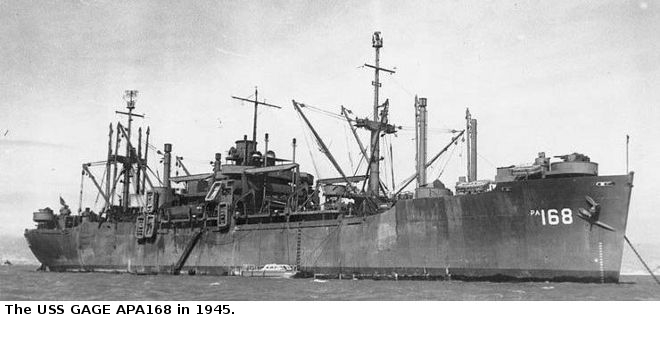
|
APA 168 USS Gage |
||||
| Click Here for Gage Main Page | ||||
 |
Officers - 56
Enlisted - 480
Troop Capacity
Officers - 80
Enlisted - 1,440
Largest Boom Capacity 35 t.
Cargo Capacity 150,000 cu. ft, 2,900 tons
Boats
two LCMs
twelve LCVPs
three LCPUs
Armament
one 5"/38 cal dual-purpose gun mount
four twin 40mm AA gun mounts
one quad 40mm AA gun mount
ten single 20mm AA gun mounts
Fuel Capacities
NSFO - 7,780 Bbls
Diesel - 970 Bbls
Propulsion
one Westinghouse geared turbine
two Combustion Engineering header-type boilers, 465psi 750 °
double Westinghouse Main Reduction Gear
three 300Kw 120V/240V D.C. Ship's Service Generators
one propeller, 8,500shp
Named after a county in Nebraska.
Gage was built under Maritime Commission contract by the Oregon Shipbuilding Corp., Portland, Oreg.; launched 14 October 1944; sponsored by Mrs. H. L. Edmunds ; acquired by the Navy 4 November 1944; and commissioned 12 November 1944, Comdr. L. J. Alexanderson, USNR, in command.
After shakedown out of San Diego, Calif., Gage sailed from San Francisco 17 January 1945 for the South Pacific. Following the landing of a military civil affairs group at Kaurimarau, Russell Islands, she arrived off West Kokum Beach, Guadalcanal, S.I., 4 February 1945 with 298 marines and military cargo. She became a unit of Division 34, Transport Squadron 12, and spent the ensuing weeks in amphibious warfare maneuvers in the Solomons. On 15 March 1945, the attack transport departed Guadalcanal for Ulithi, the staging base for the Okinawa invasion. From there she sailed to Hagushi Beach, Okinawa, where she joined in the initial assault 1 April 1945 conducted under cover of heavy naval gun and plane bombardment.
Through five grueling days and nights of almost continual "Flash Red" alerts against Japanese suicide planes, Gage landed marines of the 3rd Battalion, 4th Regiment, 6th Division; a Navy construction battalion; a medical company, and combat equipment. Her mission completed 5 April, she proceeded via the Marianas and Hawaii to San Francisco, where she arrived 11 May 1945.. Here Gage embarked the men and equipment of an Army Air Corps Casuals and landed them at Manila, Luzon, P.I., 12 June 1945.
Gage reported for duty with Amphibious Group 9 at Leyte 22 June 1945 and was dispatched to New Guinea. After embarking troops at Langemak and Humboldt Bays for transport to Iloilo, Panay Island, P.I., she steamed to San Francisco, Calif., where she arrived 2 August 1945. The announcement of Japanese capitulation found her under repair in Todd's Dry Dock at Seattle, Wash.
Gage stood out from Seattle 21 August 1945 with 1,724 Army casual replacements who disembarked at Saipan in the Marianas 5 September. Thirteen days later she departed with some 1,500 marines whom she landed late in October as part of the occupation forces at Hiro Wan, Honshu, Japan. Homeward bound, she served as the "Magic-Carpet" for 1,700 Army veterans embarked at Okinawa and Manila. She reached Portland, Oreg. 14 December 1945. The attack transport made a "Magic-Carpet" voyage from San Francisco to Yokosuka and back (10 January to 25 February 1946); followed by one to Samar, P.I., and back (4 April to 10 May 1946). She again departed San Francisco 28 May 1946 to support Navy occupation forces at the Chinese ports of Tsingtao and Tientsin and the Japanese ports of Yokosuka and Sasebo.
Gage departed Sasebo 26 June; embarked Army veterans in the Marianas and Hawaii; then transited the Panama Canal for Norfolk, arriving 29 July 1946. She remained in the Norfolk Naval Shipyard until decommissioning 26 February 1947. Gage was placed in the Atlantic Reserve Fleet and was inactive until her name was struck from the Navy List 1 October 1958 She was transferred the same day to the Maritime Commission Reserve Fleet and at present is berthed in James River, Va.
Gage received one battle star for World War II service.